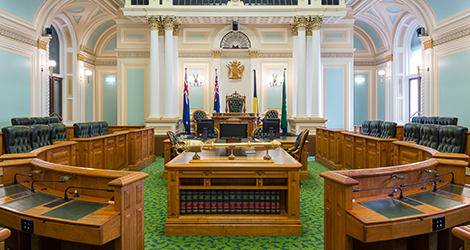I am pleased that the Council has convened a discussion on this important topic.
Climate change threatens us all, but it is women and girls who often suffer its harshest and most violent consequences.
UN Environment reports that 80 percent of people displaced by climate change are women.
And when women are displaced – with social and security structures breaking down around them – they are at far greater risk of violence, including sexual violence.
While they sleep, wash, bathe or dress in emergency shelters, tents or camps, the risk of sexual violence is a tragic reality of their lives as migrants or refugees. Compounding this is the increased danger of human trafficking, and child, early and forced marriage which women and girls on the move endure.
LGBTIQ+ women on the move are also more likely to face elevated risks of violent abuse.
Let me give you some examples of countries where we have seen these dangers play out.
Following Hurricane Katrina in the USA in 2005, the rate of rape among women displaced to trailer parks rose 53.6 times the baseline rate in the state of Mississippi for that year. LGBTIQ+ women also experienced physical harm and violence in post-disaster shelters. Following two tropical cyclones in Vanuatu in 2011, there was a 300% increase in reported domestic violence cases. And after the 2015 earthquake in Nepal, the country witnessed a four-fold increase in trafficking. Spikes in early marriages were also observed in Bangladesh coinciding with the 1998 and 2004 floods.
Around the world, we also see the dangers play out in the domain of agriculture – when climate affects harvest, land and livelihoods, women and girls face socioeconomic insecurity and inequalities and become far more vulnerable to wide-ranging consequences – from domestic violence, to child, early and forced marriage, to trafficking, to forced prostitution.
Today, thousands of women around the globe choose to stand up and speak out to fight climate change. But women environmental human rights defenders – in their work to protect lands, water, nature and communities – do so at great personal risk. They are criminalised and silenced. They are threatened and stigmatized. They are at additional risk of gender-based violence. And many are even killed.
In both Mexico and Central America for example, some 1, 698 acts of violence were recorded against women environmental human rights defenders between 2016 and 2019.
Colleagues,
While I welcome the international attention on climate change’s impact on women and girls over the last decade, we must urgently also focus on the grave issue of violence against them which has been exacerbated by the climate crisis.
As we strive today to look at this issue with a human rights lens, we need to ensure that climate change policies and approaches place the human rights of women and girls front and centre.
How do we ensure no-one is left behind?
The first step is recognition. Acknowledging that climate change and violence against women are linked. That we cannot leave anyone behind – this includes indigenous women, women of African descent, Roma women, women from religious minorities, women with disabilities and LGBTIQ+ women.
Second, equal, full and effective participation and leadership of women on climate issues is key. Women must be fully involved in decision-making, planning and implementation of approaches to climate action. It is their insights, their lived experience and their guidance on the issues that directly affect them that will enable better protection of their rights, and stronger, more effective climate action.
We need their voices – and their leadership – to take us on the right path.
Third, States need to strengthen the design and effective implementation of gender-responsive environmental and disaster risk reduction policies, programmes and budgets. This will involve ensuring women’s leadership in disaster risk management, providing sufficient financial resources and putting in place effective monitoring mechanisms. It will mean empowering women for disaster preparedness and building their capacity to secure alternate means of livelihood if ever needed. It will include prioritising women’s equal access to information and credit. And it will imply guaranteeing that, in times of disaster, women have access to health care, sexual and reproductive health, support services, shelter and security.
Fourth, States have to enhance accountability frameworks: there must be zero impunity for perpetrators of gender-based violence, no matter if they are spouses, family members, religious leaders, relief workers or government officials.
And fifth, States must take urgent steps to respect, protect and fulfil their human rights obligations to women and girls, and in particular women environmental human rights defenders. This includes guaranteeing their rights to freedom of expression, assembly, association, and participation in decision-making at all levels. And they must also provide women with redress and accountability for threats and harms that they endure.
Colleagues,
We are in a race against time before the planet bears the full force of the climate crisis. Let’s not forget the human rights of those in the most marginalized and vulnerable situations who lie in its path.
I recognise the need for deeper discussion, assessment, and analysis on these issues. But unless we move from rhetoric to concrete action – immediately – the lives, safety and dignity of millions of women and girls will continue to hang in the balance.
I count on the members of this Council to make this an urgent priority.
Thank you for your attention.







